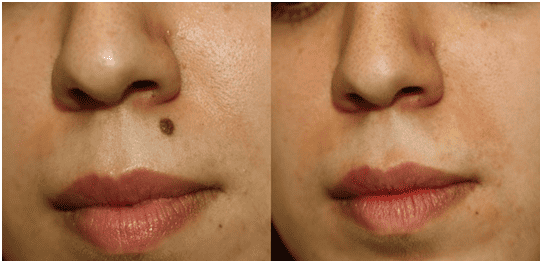MOLES REMOVAL TREATMENT
Moles are also called as nevi and they are basically a cluster of pigmented cells which are seen on the skin as brown or black spots. There are different types of moles. Most moles are harmless, but a few could be cosmetically unappealing or rarely may turn cancerous. They can appear on any part of the body and by the time you reach adulthood, you could have around 10-40 moles. With age, some of the moles disappear and few others change their colour or may grow in size.
A mole is formed when a group of cells called melanocytes come together and grow in a cluster at a particular spot on the body. They may be flat or raised above the skin.The different types are congenital moles (formed during birth) and acquired moles (which appear later in life). However, if painless moles turn painful, begin to itch or start bleeding, increase rapidly in size or if there is any asymmetry then it is advisable to consult a dermatologist.

WHY PLAC?
Not all moles are lucky or beautiful; removing them becomes necessary for aesthetic and health benefits. Moles removal at PLAC is outstanding because:
- Every patient is assessed and customised treatments are offered.
- Evidence based and tested protocols with stringent guidelines assure efficacy and safety
- Conveniently located state-of-the-art facilities with peaceful ambience.
- Treatment is done only by the experienced dermatologists who have both skills and expertise to remove moles.
- Complete discreet, dignified, and confidential service by assigning individual consultation and service room to every client.
- We have treated thousands of moles and have gained immense patient satisfaction rating of 94%
FREQUENTLY ASKED QUESTIONS ON MOLES REMOVAL
Moles become a health concern when they stand out on the skin causing displeasure or when they have a potential to become cancerous. Moles can be treated either by a minor surgical procedure called electrocautery or radiofrequency, punch excision or through Q switched ND:YAG laser.At times, a combination of treatments may be required.
Whatever the procedure chosen to treat moles, a local injectable anesthesia is given or local anesthetic cream is applied on target area while performing the treatment to ensure you don’t experience the slightest pain or discomfort.
If the moles are large then it would require a deep surgery and once the excision is done, sutures are required.
The usual healing time would be about one week to 10 days for large size moles and 3-4 days for smaller ones.
Utmost care is taken by our dermatologists at PLAC not to leave behind deep scars. There may be some spots left post procedure can be lightened by the skin lightening creams that our doctor will prescribe.

